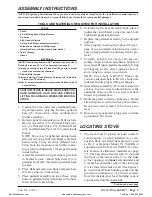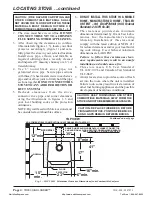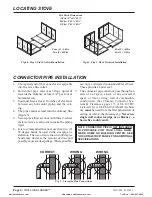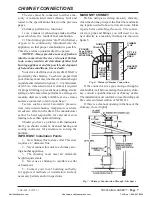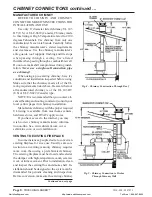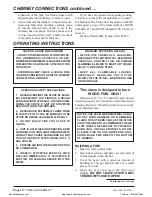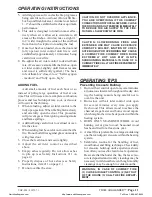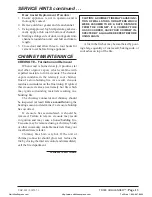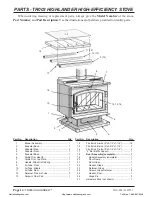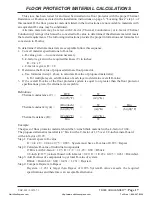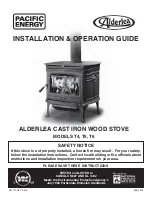
VGZ-028 / 030707.1
TR003 HIGHLANDER™
/
Page
OPERATINg INSTRUCTIONS
5. Add large pieces of wood as the fire progresses
being careful not to overload. (Do not fill fire-
box beyond firebrick area.) An ideal coal bed of
1 –2” should be established t achieve optimum
performance.
6. This unit is designed to function most effec-
tively when air is allowed to circulate to all
areas of the firebox. An idea; rake a slight (1˝
to 2˝ wide) trough in the center of the coal bed
from front to back prior to loading the fuel.
7. Once fuel has been loaded, close the door and
fully open air inlet control until fire is well
established (approximately 10 minutes) being
careful not to overfire.
8. Re-adjust the air inlet control to desired burn
rate. (If excessive smoke fills the firebox, open
air inlet control slightly until flames resume
and wood is sufficiently ignited.) The basic
rule of thumb is “closed - low,” “half way open
- medium” and “fully open - high.”
ADDING FUEL
Add small amounts of fuel each hour or so
instead of piling large quantities of fuel at one
time. This will insure a more complete combustion
process and less buildup of tars, soot, or creosote
will occur in the chimney.
1. When refueling, adjust air inlet control to the
fully open position. When fire brightens, slowly
and carefully open the door. This procedure
will prevent gases from igniting causing smoke
and flame spillage.
2. Add fuel being careful not to overload or over-
fire the stove.
3. When adding fuel be careful not to smother the
fire. Do not build fires against glass on models
with glass door.
3. Close the feed door and secure tightly.
4. Adjust the air inlet control as described
above.
5. Empty ashes regularly. Do not allow ashes
to pile up (see Safety Instructions #11 on
page 2.)
6. Properly dispose of hot ashes (see Safety
Instructions, item #11 on page 2.)
7. Do not overfire the stove.
CAUTION: DO NOT OVERFIRE APPLIANCE.
YOU ARE OVERFIRING IF THE CHImNEY
CONNECTORS OR STOVE GLOwS RED. CLOSE
THE DOOR AND SHUT DAmPER ImmEDIATELY
TO REDUCE THE AIR SUPPLY TO THE FIRE.
THIS wILL SLOw DOwN THE FIRE.
CAUTION: SLOw BURNING FIRES AND
ExTENDED USE mAY CAUSE ExCESSIVE
CREOSOTE BUILDUP. IGNITION OF CREO-
SOTE BUILDUP OR OVERFIRING mAY CAUSE
A CHImNEY FIRE. CHImNEY FIRES BURN
E x T R E m E LY H O T A N D m AY I G N I T E
SURROUNDING mATERIALS. IN CASE OF A
CHImNEY FIRE CALL THE FIRE DEPARTmENT
ImmEDIATELY.
OPERATINg TIPS
Preventing Creosote Buildup
1. Burn with air control open for several minutes
at numerous intervals throughout the day dur-
ing the heating season, being careful not to
over-fire the unit.
2. Burn stove with air inlet control wide open
for several minutes every time you apply
fresh wood. This allows wood to achieve the
charcoal stage faster and burns wood vapors
which might otherwise be deposited within the
heating system.
3. BURN ONLY SEASONED WOOD. Avoid
burning wet or green wood. Seasoned wood
has been dried for at least one year.
4. A small fire is preferable to a large smoldering
one that can deposit creosote within the heating
system.
5. Establish a routine for the handling of fuel,
wood burner and firing technique. Check daily
for creosote build-up until experience shows
how often you need to clean for safe operation.
Be aware that the hotter the fire, the less creo-
sote is deposited and weekly cleanings may be
necessary in mild weather even though monthly
cleanings may be enough in colder months.
wARNING: IN CASE OF CHImNEY FIRE
(1) CLOSE AIR INLET CONTROL (2) GET OUT
OF THE HOUSE (3) CALL THE FIRE DEPART-
mENT.
NorthlineExpress.com
http://www.northlineexpress.com
Toll-Free 1-866-667-8454



